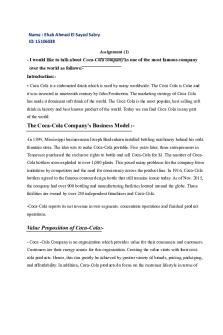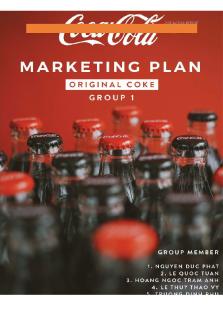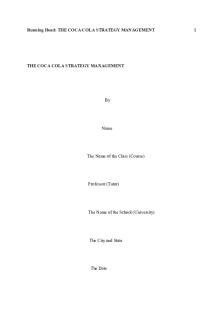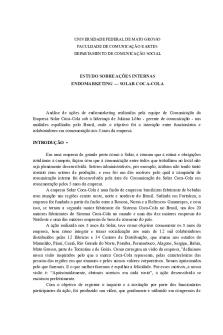Coca cola assignment - finace PDF

| Title | Coca cola assignment - finace |
|---|---|
| Author | marwan mohamed |
| Course | Economic Development |
| Institution | جامعة القاهرة |
| Pages | 5 |
| File Size | 241.3 KB |
| File Type | |
| Total Downloads | 49 |
| Total Views | 137 |
Summary
finace...
Description
Name : Ehab Ahmed El Sayed Sabry ID: 15106038 Assignment (1)
- I would like to talk about Coca-Cola company as one of the most famous company over the world as follows:Introduction:-
- Coca Cola is a carbonated drink which is used by many worldwide. The Coca Cola is Coke and it was invented in nineteenth century by John Pemberton. The marketing strategy of Coca Cola has made it dominant soft drink of the world. The Coca Cola is the most popular, best selling soft drink in history and best known product of the world. Today we can find Coca Cola in any part of the world.
The Coca-Cola Company's Business Model :-In 1894, Mississippi businessman Joseph Biedenharn installed bottling machinery behind his soda fountain store. The idea was to make Coca-Cola portable. Five years later, three entrepreneurs in Tennessee purchased the exclusive rights to bottle and sell Coca-Cola for $1. The number of CocaCola bottlers soon exploded to over 1,000 plants. This posed many problems for the company from imitations by competitors and the need for consistency across the product line. In 1916, Coca-Cola bottlers agreed to the famous contour design bottle that still remains iconic today. As of Nov. 2015, the company had over 900 bottling and manufacturing facilities located around the globe. Those facilities are owned by over 250 independent franchises and Coca-Cola. -Coca-Cola reports its net revenue in two segments: concentrate operations and finished product operations.
Value Proposition of Coca-Cola:- Coca -Cola Company is an organization which provides value for their consumers and customers. Customers are their energy source for this organization. Creating the value starts with their coca cola products. Hence, this can greatly be achieved by greater variety of brands, pricing, packaging, and affordability. In addition, Coca-Cola products do focus on the customer lifestyle in terms of
satisfaction. For example, if a person were to be on a diet, well there is diet coke. Hence, Coca Cola does engage in the customer needs in terms of the product. Coca- Cola has over nearly 400 brands (including water, juice, teas, coffees, energy drinks, and especially sodas) and wants to engage consumers to try something refreshing and new. It really comes down to choices for consumer in terms of coca cola products. Coca-cola brands include Fruitopia, Fanta, Sprite, Dasani, Nestea, Powerade, and many more brands. One of Coca-Cola’s slogans was “Open Happiness.” This slogan was represented to the consumers and was meant to letting the consumers enjoy their products. Coca Cola is able to meet today’s non-alcoholic beverage needs of consumers. Coca Cola’s current value proposition is “The Coke Side of Life” which represents happiness when you open up a can of coke or any other Coca-Cola product. “The Coke Side of Life” explains that it is an enjoyable, comfortable, and sociable environment when one actually consumes a Coca-Cola product. - Rationale: Coca Cola Company continues to work on research/development and focus on making new products. For instance, a can of coke has a secret formula that will be difficult to imitate. Coca Cola products are significant because they make each product unique.
Coca-Cola Revenue 2006-2020 | KO -Coca-Cola annual/quarterly revenue history and growth rate from 2006 to 2020. Revenue can be defined as the amount of money a company receives from its customers in exchange for the sales of goods or services. Revenue is the top line item on an income statement from which all costs and expenses are subtracted to arrive at net income.
Coca-Cola revenue for the quarter ending September 30, 2020 was $8.652B, a 8.99% decline year-over-year.
Coca-Cola revenue for the twelve months ending September 30, 2020 was $33.471B, a 8.74% decline year-over-year.
Coca-Cola annual revenue for 2019 was $37.266B, a 8.65% increase from 2018.
Coca-Cola annual revenue for 2018 was $34.3B, a 5.28% decline from 2017.
Coca-Cola annual revenue for 2017 was $36.212B, a 13.5% decline from 2016.
The Marketspace of Coca-Cola - All bottling partners work closely with customers –grocery stores, restaurants, street vendors, convenience stores, movie theaters and amusement parks, among many others –to execute localized strategies developed in partnership with our company. Customers then sell our products to consumers at a rate of 1.9 billion servings a day.
The Coca-Cola Company competitors - The Coca-Cola Company's top competitors include Keurig Dr Pepper, Tropicana Products, PepsiCo, Britvic, Red Bull, Fever-Tree and Monster Beverage.
Competitive advantage - Competitive advantage, an advantage over the competitor which is gained by offering consumer the greater value, by either lower price or by providing more benefit that justify higher price(Kotler & Armstrong, 2008). - Competitive advantage is an ability of a company to perform in one or more ways that the competitors cannot or will not match. A company must have a sustainable competitive advantage because it benefits the company in longer runs. Competitive advantage gives
customer advantage for example if Coca Cola deliver its product better than any other competitors then customers will choose Coca Cola over other companies.
Coca-Cola’s Marketing Strategy -Like other companies, Coca-Cola bases its marketing strategy on the well-known marketing mix of the “4Ps”: Product, Price, Promotion, and Place. -However, due to the uniqueness of the company’s brand, they’ve mixed things up a bit by including other, more subtle reasons behind the company’s success and the uniqueness of the brand.
The Coca-Cola Company Executive Team -The Coca-Cola Company Executive Team is rated a "C+" and led by CEO James Quincey, Executive Vice President Irial Finan, and VP, Assistant Controller & Chief Accounting Officer Mark Randazza. The Coca-Cola Company employees rate their Executive Team in the Top 50% of companies in the United States with 10,000+ Employees.
BOARD OF DIRECTORS Board of directors strongly believes in the bright future of their brands, their business and the positive impact they have, and should have, on local communities Name Herbert A. Allen
Ronald W. Allen Marc Bolland
Committee Management Development Committee (Chair) Executive Committee Finance Committee Audit Committee (Chair) Audit Committee Committee on Directors and Corporate Governance
Ana Botín
Finance Committee Human Capital Management and Compensation
Christopher C. Davis
Barry Diller
Finance Committee Finance Committee (Chair) Executive Committee
Committee on Directors and Corporate Governance
Management Development Committee Human Captial Management and Compensation Committee (Chair)
Helene D. Gayle
Public Issues and Sustainability Committee Public Policy and Sustainabilty Committee (Chair)
Human Capital Management and Compensation Committee Finance Committee
Management Development Committee Committee on Directors and Corporate Governance (Chair) Management Development Committee
Human Capital Management and Compensation Committee Executive Committee (Chair) Public Issues and Diversity Review Committee
Audit Committee
Alexis Herman
Bobby Kotick
Maria Elena Lagomasino James Quincey Caroline Tsay
Divisional organization by geographic areas...
Similar Free PDFs

Coca cola assignment - finace
- 5 Pages

COCA COLA assignment official
- 15 Pages

Coca Cola 2017-10K - Assignment
- 170 Pages

Coca cola
- 7 Pages

Coca Cola-SWOT - Coca Cola-SWOT
- 4 Pages

PROCESO ADMINISTRATIVO COCA COLA
- 1 Pages

COCA-COLA CASE STUDY
- 13 Pages

Coca Cola Strategy Management
- 9 Pages

Endomarketing - Solar Coca-Cola
- 5 Pages

Coca cola case study
- 2 Pages

Coca Cola Sustainability
- 11 Pages

Synthèse exposé coca-cola
- 2 Pages
Popular Institutions
- Tinajero National High School - Annex
- Politeknik Caltex Riau
- Yokohama City University
- SGT University
- University of Al-Qadisiyah
- Divine Word College of Vigan
- Techniek College Rotterdam
- Universidade de Santiago
- Universiti Teknologi MARA Cawangan Johor Kampus Pasir Gudang
- Poltekkes Kemenkes Yogyakarta
- Baguio City National High School
- Colegio san marcos
- preparatoria uno
- Centro de Bachillerato Tecnológico Industrial y de Servicios No. 107
- Dalian Maritime University
- Quang Trung Secondary School
- Colegio Tecnológico en Informática
- Corporación Regional de Educación Superior
- Grupo CEDVA
- Dar Al Uloom University
- Centro de Estudios Preuniversitarios de la Universidad Nacional de Ingeniería
- 上智大学
- Aakash International School, Nuna Majara
- San Felipe Neri Catholic School
- Kang Chiao International School - New Taipei City
- Misamis Occidental National High School
- Institución Educativa Escuela Normal Juan Ladrilleros
- Kolehiyo ng Pantukan
- Batanes State College
- Instituto Continental
- Sekolah Menengah Kejuruan Kesehatan Kaltara (Tarakan)
- Colegio de La Inmaculada Concepcion - Cebu



